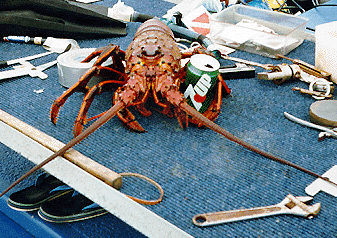A Time To Dive - The Golden Doubloon

It's Thirsty Work
CopyRight @ 1997
My favorite tub was the Golden Doubloon. It was the first California
Dive Charter boat, run by the famous treasure hunter Mel Fisher. When I
went on it, the skipper was Eddie Tanaka and it was slow. I started
diving on it in about 1972, with trips to San Clemente, Catalina,
Santa Barbara and even once to San Nicolas Islands. In the early 70's
it was one of the biggest of the local dive boats and it was
frequently chartered by Aloha Dive Shops. That was an NASDS crowd, so
the equipment one saw on the boat could be anything. A lot of these
guys were aerospace engineers and they would even make gear.
This was primarily warm weather diving. It tends to be much nicer
weather at the southern Channel Islands than it is further north. It's
great to wake up on a sunny day on a calm ocean. The diving tended to
be rather casual. There might be a line at the gate in lobster season,
but unlike some other boats, no one was prodding the person in front of
them, with a dive knife.
We were anchored near a kelp bed off the front side of Catalina
early one morning. Johnny and I were in quickly and decided to go
straight down to the reef instead of swimming the 100 feet to where the
kelp actually started. We went down quickly and I guess we both felt
the depth because we each showed our depth gauges to the other. It was
110 feet and my suit was squeezed. We quickly moved to the reef and
went up the nearly vertical face. I quickly saw what people said about
it being called Eel Reef rather than Eagles Reef. There were big morays
in every crack and hole.
The reef was as beautiful as anything you were likely to find on
the entire island. Catalina has many smaller lacey golden algaes that
give the reefs a gold glow. There were large Sheepheads and Kelp Bass
everywhere, along with many perch and other smaller fish.
It turns out that Eagles reef is actually 5 large pinnacles, about
1/4 mile offshore, just a bit west of the Isthmus. There is a great deal
of vertical in this area and one of the pinnacles comes to within about
10 feet of the surface.
Between about 60 and 70 feet was an area of Elephant Ear Kelp. This
large Laminarea (brown algae) has a small stalk and a single huge 'leaf'
that is about 2 feet wide and 40 feet long. The leaves lay about 18 inches
off the bottom in a mat and can only grow where the water is consistently
calm. I went under this. It is clearly separated from above by the solid
mat of leaves and though a bit dim, it is quite easy to see in the area
below it. Little other algae grew on the rocks below it, but there were
numerous Corynactis anomenes and sponges. There also were numerous Sculpin
or Scorpion Fish. These are neat looking orange rockfish that sit on the
rocks and in the cracks. Their back spines carry a toxin that can cause
great pain if you are stabbed by one. Apparently, very hot water can
potentially denature the toxin, but I had no interest in finding out.
Since there seemed little else to see and I didn't really like seeing
the Sculpins, I left that place and continued in the open up the reef.
It was fascinating in the way that healthy reefs are. In the clear
water on a sunny day, colors are brilliant. At the top of the reef, it
was completely different than the terrain lower down. There was a fair of
surge near the top. I was crossing an area of rocks with some brilliant
green Eel Grass and all kinds of Perch, when I heard a bump. I went to
the surface and a private boat had hit the red warning buoy above the
reef, while trying to tie up to it. It was neither legal nor bright. I
swam over to it and looked at the hull. The guy on the deck was happy to
hear that there was no apparent damage.
I continued along the reef back towards the boat until out of air.
Johnny was already there. We had time. I told him to go down to 100 feet
on the edge of the reef, where we had been, and I would try to free dive
to him. This was when I was really into free diving. He grabbed a tank
and we went to near the kelp, where he went down. I waited a bit, did a
sharp surface dive and dropped down quick. Sure enough, I wasn't hunting
or anything and so easily got down to him. He was on the bottom though,
so I figger it was at least 110 feet. That was the deepest that I ever
tried.
A note. Nobody really took any game, though most people were at
least casual hunters. Nobody, that is except Tom and another guy. They
both got well more than the then limit of 5 abalone. These were nice big
fat Green Abalone. Great eating and the shells were considered jewelry
quality. Where were they? I looked and I didn't see a hint of these
anywhere, yet these two guys had cleaned up. Under the Elephant Ear Kelp.
There were lots of them. Further, Tom had used his knife to stab some of
the Skulpin, which are very tasty. This was when I decided that the best
way to dive was to go where other people wouldn't. That is how to find
the game and the unusual. It is one of my primary rules of diving.
There was this engineer that machined abalone irons and
steel single teeth out of aerospace type stainless steels.